Art of Individuals With Six Crucified Children on Their Backs
This article is agonizing. In that location is nothing pleasant virtually crucifixion.
 However, having an agreement of crucifixion helps usa sympathise what Jesus went through on the solar day of his expiry. This article is based on various articles written by medical doctors, including a study by the Mayo Clinic published in the Journal of the American Medical Association in 1989.
However, having an agreement of crucifixion helps usa sympathise what Jesus went through on the solar day of his expiry. This article is based on various articles written by medical doctors, including a study by the Mayo Clinic published in the Journal of the American Medical Association in 1989.
Crucifixion probably started first with the Persians (what is modernistic day Iran). Initially, the victim was suspended to go along their feet from touching holy ground. The Phoenicians, traders to many lands, seem to have besides acquired the practice and probably spread information technology to other cultures, including the Greeks.
Alexander the Swell (a Greek) introduced the exercise to Carthage, where it was picked up past the Romans. The Romans started using it around the time Jesus was born.
The Romans perfected crucifixion equally a penalty designed to maximize pain and suffering. Information technology wasnt well-nigh killing somebody — it was about killing somebody in a really horrible way. Someone who was crucified suffered the maximum amount of hurting.
Crucifixion was as well the virtually disgraceful form of execution. It was commonly reserved for slaves, foreigners, revolutionaries, and vile criminals. The only time a Roman citizen was ever crucified was for desertion from the ground forces.
What was flogging?
Flogging, or scourging, was washed before every crucifixion. The scourging was intended to bring a victim to a state just short of death.
Likewise, it hurt. A lot.
The whip had fe balls tied a few inches from the end of each leather thong on the whip. Sometimes, sharp sheep basic would be tied near the ends. The iron balls would cause deep bruising, while the leather thongs would cut into the peel. The sheep basic would hasten the process of cutting into the peel. After a few lashes, the pare would be cut through, and the muscles would begin to be cut. Blood loss was considerable, and the pain would probably have put the victim in a land of stupor.
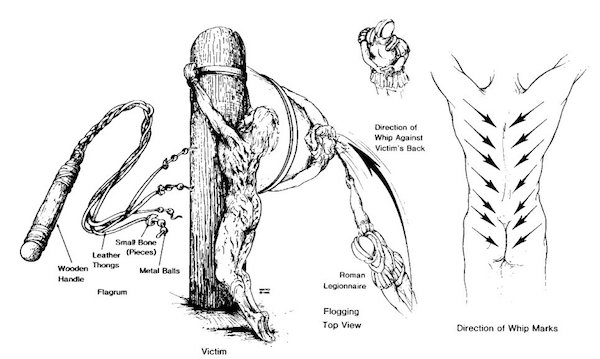
What was a typical crucifixion like?
Subsequently the flogging, the victim would comport his own cross bar (called a patibulum) from the flogging surface area inside the metropolis to the crucifixion area outside of the metropolis walls. The crucifixion area was e'er outside the city, because the procedure was horrible and disturbing to citizens.
The upright part of the cross (the stipe) was permanently mounted in the crucifixion area. The role that the victim carried was the cross bar, weighing in at 75 to 125 pounds. The cantankerous bar would be balanced on the victims shoulders, and their artillery would be tied to the crossbar. In this position, if the victim tripped or brutal, they could not use their arms to break their fall, and they would probable fall face first into the footing.
The victim was escorted by a Roman guard (probably a centurion and several soldiers), who were responsible for guarding the victim until his death. One of the soldiers would display a sign with the crime written on it.
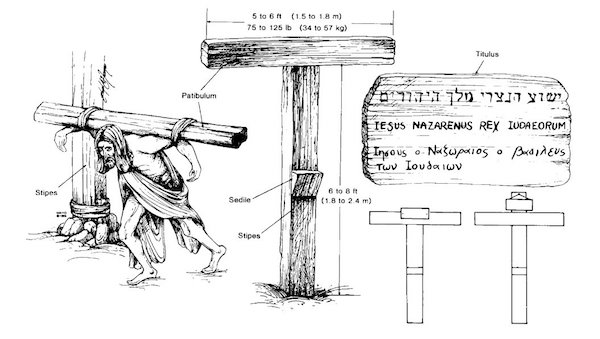
Once the crucifixion area was reached, the victim would be offered a potable of wine mixed with myrrh to act equally a mild pain killer. The beverage was a charitable service performed past an clan of women in Jerusalem.
So they offered him vino mixed with myrrh, merely he did not take information technology. - Mark fifteen:23
The victim would and so be nailed to the cross bar. The nails would be driven through the wrists, not through the palms, as these would not support the trunk weight.
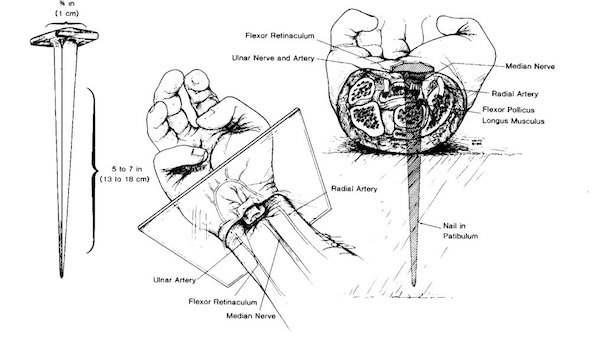
The cross bar would exist raised and placed on the upright post, where the victims heels would be nailed to the post.
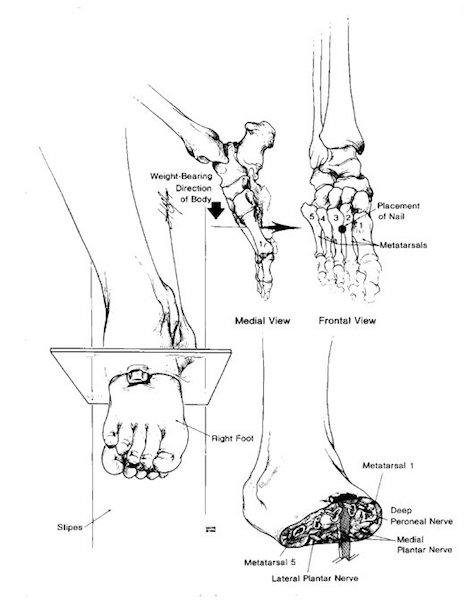
Once crucified, a victim would alive for a flow ranging from a few hours to a few days. How long he lived depended mostly on how astringent the scourging was.
If no one claimed the body, it would be left on the cross to be eaten by predatory animals. The family could, however, merits the torso for burial. In this instance, a Roman soldier would pierce the chest with a sword or spear to make sure the victim was dead.
What actually kills the victim?
The initial scourging would weaken the victim, crusade massive blood loss, and probably induce shock. By the time the victim had carried thecross bar to the crucifixion surface area, he would be wearied.
Once up on the cross, the victim would have his trunk weight suspended by their arms. In this position, it is difficult to completely breathe. The victim could take shallow breaths for a while, but somewhen would exist forced to push himself up to have a full breath.
At this point three things happen:
- The victim's weight is now fully supported past his feet. The nails through the feet would be likely to hit 2 major nerves running through the area. The effect would exist excruciating pain in the legs.
- The nails in the wrists would be likely to pierce the main nerve running through the arm. As the victim pushed upwardly to breath, the wrists would rotate against the boom, irritating the nerves and causing intense pain in the arms. Some authorities too believe that the crucifixion position would dislocate the shoulder or elbow. Any movement would aggravate the pain from these injuries.
- The wounds on the victims back from the scourging would push upwardly against the rough part of the centerpiece. This would tend to re-open the wounds, leading to more than pain and blood loss.
This combination of pain would speedily force the victim to lower himself back down. Eventually, the victim would no longer be able to raise himself up and would suffocate. The shock from blood loss due to the scourging would hasten this process.
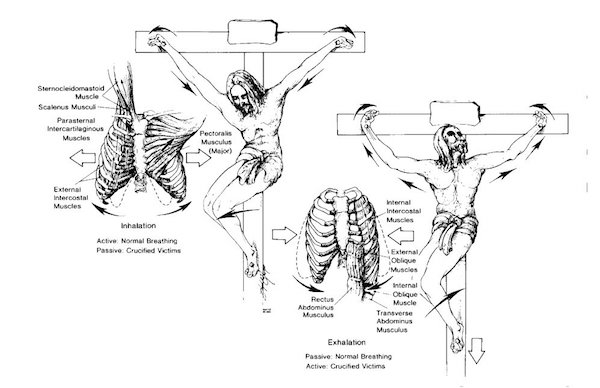
In some cases, the victims legs were broken to stop him off. This would forbid the victim from beingness able to enhance himself up and hewould suffocate in a matter of minutes.
Specifics of Jesus crucifixion
Jesus crucifixion mostly followed the standard procedure, although at that place were some differences. These differences aid account for the fact that he died after a relatively brusk period of time on the cross.
And being in anguish, he prayed more than earnestly, and his sweat was like drops of blood falling to the ground. - Luke 22:44
There is a condition called hemohidrosis or hematidrosis which occurs in people under farthermost physical or emotional stress. The blood vessels in their sweat glands rupture and leak claret into their sweat. The effect is one of sweating blood. Several authorities believe that this is a plausible explanation for what happened to Jesus.
Although the loss of blood would non be meaning, it shows that he was under extreme stress, which would have weakened him physically.
The men who were guarding Jesus began mocking and beating him. - Luke 22:63
And then some began to spit at him; they blindfolded him, struck him with their fists, and said, Prophesy! And the guards took him and shell him. - Mark fourteen:65
Then they spit in his face up and struck him with their fists. Others slapped him - Matt 26:67
When Jesus said this, ane of the officials nearby struck him in the face up. Is this the way you respond the high priest? he demanded. - John xviii:22
Earlier the scourging and crucifixion, Jesus was beaten past his guards, which would weaken him. In improver, he would have had no sleep that night, and walked back and forth from trial to trial.
A certain man from Cyrene, Simon, the father of Alexander and Rufus, was passing by on his style in from the country, and they forced him to deport the cross. - Mark 15:21
As they were going out, they met a human being from Cyrene, named Simon, and they forced him to acquit the cross. - Matt 27:32
Equally they led him away, they seized Simon from Cyrene, who was on his manner in from the state, and put the cross on him and made him carry it behind Jesus. - Luke 23:26
Typically, a prisoner carried his own cantankerous to the crucifixion site. The fact that Simon was pressed into conveying Jesus cross suggests that Jesus was too weak to behave his ain cross.
It was Preparation Day (that is, the twenty-four hours earlier the Sabbath). So every bit evening approached, Joseph of Arimathea, a prominent member of the Council, who was himself waiting for the kingdom of God, went boldly to Pilate and asked for Jesus body.
Pilate was surprised to hear that he was already dead. Summoning the centurion, he asked him if Jesus had already died. - Marker xv:42-44
Since the Jewish Sabbath would begin at Sunset, it was of import that the bodies not exist left upwardly, as Jewish law required that they be buried by the Sabbath.
Note that Pilate is surprised that Jesus is already expressionless.
Now it was the 24-hour interval of Preparation, and the next day was to be a special Sabbath. Because the Jews did not want the bodies left on the crosses during the Sabbath, they asked Pilate to have the legs broken and the bodies taken downwardly.
The soldiers therefore came and broke the legs of the offset human being who had been crucified with Jesus, and so those of the other. - John 19:31-32
Equally mentioned earlier, breaking the legs of a crucified person would crusade suffocation inside minutes, because they would non be able to raise themselves up to breath.
But when they came to Jesus and constitute that he was already expressionless, they did not interruption his legs. Instead, 1 of the soldiers pierced Jesus side with a spear, bringing a sudden menses of claret and water. - John 19:33-34
Again, this was typical crucifixion do — to stab the victim to brand sure he was dead before releasing him to relatives.
The water that John describes every bit flowing is probably serous pleural and pericardial fluid — fluid that would build up from daze and blood loss. This fluid would tend to accrue in the chest cavity and lungs.
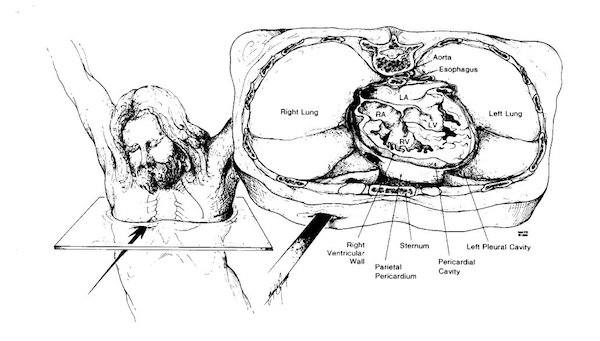
Short $.25
A jar of wine vinegar was there, and then they soaked a sponge in it, put the sponge on a stalk of the hyssop plant, and lifted it to Jesus lips. - John nineteen:29
The second drink, which He accepts moments earlier His death, is described as a wine vinegar. Two points are of import to note. The drinkable was given on the stem of a hyssop plant." Remember that these events occurred at the Feast of the Passover. During this feast, (Exod 12:22) hyssop was used to apply the claret of the Passover lamb to the wooden doorposts of the Jews.
Source: https://www.catholiceducation.org/en/controversy/common-misconceptions/the-facts-of-crucifixion.html
0 Response to "Art of Individuals With Six Crucified Children on Their Backs"
Post a Comment